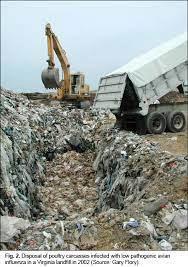Operators of egg production units that have been depopulated following HPAI infection are required to conform to USDA-APHIS and state requirements before restocking. The initial stipulation is non-recovery of viable HPAI virus on environmental sampling after completion of the 14-day period following decontamination and mitigation measures.

A number of the requirements conform to the structural and operational biosecurity procedures to prevent Salmonella Enteritidis and are based on current knowledge of the mode of transmission of avian influenza, including bird and rodent proofing of buildings and the use of protective other clothing and footwear. The USDA requirement as stated in Section 3(g) relating to “barn specific clothing and boots to be kept in the barn’s entry way” would be appropriate for a single-barn contract farm but separate clothing for individual houses is irrelevant in the context of HPAI that is in all probability transmitted by the aerogenous route at least between houses on a large multi-age complex with high rates of powered air movement. The requirement that separate footwear be used within houses to prevent introduction of virus from the exterior into houses is however relevant.
 The requirements for surveillance after stocking are valid with specific concern for even mild elevated mortality in a flock.
The requirements for surveillance after stocking are valid with specific concern for even mild elevated mortality in a flock.
The criteria imposed by APHIS for restocking are broad but do allow for specific circumstances relating to a complex.
The fact that at least one complex required a second depletion due to HPAI within a six-month period with a second payment of indemnity should result in an intensification of epidemiologic studies by APHIS to ascertain routes of entry, including wind-borne transmission over distances to be determined.
In September, the USDA published an advanced notice of proposed rulemaking and a request for comments relating to indemnity. The criteria and procedures regulating payment to owners of flocks following destruction and disposal of livestock and poultry by the Animal and Plant Health Inspection Service will be published in the Federal Register when finalized. This will include action following isolation of H5 and H7 strains of avian influenza of low pathogenicity.
Extensive depopulation of poultry to date during the 2022 epornitic and concerns over introduction of exotic diseases such as African swine fever have necessitated a review of existing procedures to establish the value of livestock.